Biostats Final
1/59
There's no tags or description
Looks like no tags are added yet.
Name | Mastery | Learn | Test | Matching | Spaced |
|---|
No study sessions yet.
60 Terms
Why do we collect data?
To answer if variability is real or not
Systematic error
The error only goes towards one direction
Ex: If we are measuring weight with an uncalibrated scale, it will add or reduce the weight systematically
Random error
Due to chance, the error can go into both directions
Ex: If we take two samples of the class and measure your weight, the difference can vary for both directions
Quantitative data
Numeric
Qualitative data
Categorical
Types of quantitative data
Continuous
Discrete
Types of qualitative data
Binary
Nominal
Ordinal
Continuous variables
Variables that describe the values of a continuous scale
Ex: weight, BMI, height
Discrete variable
Variable that describea the values of finite events, usually based on whole numbers
Ex: number of siblings, age…
Binary variable
Variable that describe the values of any event that only has two categories
Ex: death (yes, no), physically active (active, non-active)
Nominal variable
Variable that describes the values of any event that has two or more categories without order
Ex: who are the people that live with you? (live alone, partner, friend, family…), NBA team (Lakers, Bulls….)
Ordinal variable
Variable that describe the values of any event that has two or more categories with an order
Ex: grade in the course (A,B,C…), BMI (normal, overweight, obese…)
Mean (central tendency)
sum of the values of one variable, divided by the number of values
Median
A central tendency estimate that is exactly in the middle of the sample, dividing the sample in half
Can be used to address outlier issues
Equation: Even numbers: Average of n/2 and (n+2)/2
Odd numbers: (n+1)/2
Variability measures
Min and Max values (amplitude)
Position measures
Variance
Standard deviation
Coefficient of variation
Standard error
Min and Max values (range)
The difference between the extreme values
Position measures
Measures that separate the observations in equal parts (or almost), like the median
Ex 1: Quintiles
1 (20%), 2 (20%), 3 (20%), 4 (20%), 5 (20%)
Ex 2: Percentiles
P10 (10%), P5 (5%), P50 (50%)
Variance
An average of the difference (squared) of each observation in relation to the overall mean
Squared because the differences can have negative values
Result doesn’t have the same unit as the individual values or the mean
Standard deviation
Square root of the variance
How much, in average, each value is to the mean
Uses the same unit as the original variable
Standard Error
Shows how much the sample mean is likely to vary from the population mean due to random error or sampling
Smaller SE suggests a more accurate representation of the population mean, while a larger SE indicates more uncertainty
Variation coefficient
(Standard deviation/mean)*100
The ratio of the standard deviation to the mean, often expressed as a percentage
Allows for comparisons between data sets with different means or units
Interquartile range
Range based on the 25th percentile and 75th percentile
What can we use categorical variables to measure?
Frequency
Count, raw number of events
Probability
The portion of the number of events compared to the sample
% of individuals with cancer
Odds
Chance
Comparison of individuals
Odds of having cancer compared to not having cancer
Probability
number of favorable outcomes/ number of possible outcomes
multiplicative rule for probability
used for the probability of the occurrence of both of two events, A and B
Prob(A and B)= Prob(A) x Prob (B)
Additive rule for probability
used for the occurrence of at least one of event A or event B (either)
Prob(A and B)= Prob (A) + Prob(B)-Prob(A+B)
Odds
Considers the probability of a successful event compared to a probability of a failure/unsuccessful event
Can present values from 0-infinity (not percentage)
Prevalence
represents the burden of disease in a particular time
number of people with the disease at particular point in time/total population
Incidence
represents the burden of new cases from a disease
risk=cumulative incidence= number of new cases of disease in period/number initially disease-free
Normal distribution
Used for continuous variables
Symmetrical around the mean
Bell-shaped
Describes biological events well
Values in the middle of the distribution are more frequent
Is tall and narrow when the standard deviation is low
Short and wide for higher standard deviation
central limit theory
Principle that the distribution of sample means approximates a normal distribution as the sample size gets larger, regardless of the population’s distribution
parameters to know if the distribution is normal
skewness
kurtosis
statistical test
visual interpretation
skewness
a measure of lack of symmetry. values close to 0 indicate normal distribution, or symmetry
kurtosis
a measure that describes how heavily the tails of a distribution differ from the tails of a normal distribution
values close to 3 indicate normal distribution
What is the problem if the distribution is not normal?
Can’t use MEAN as the central tendency measure, because it will be biased, instead we must:
must use other measures like MEDIAN
categorize the variable
make a transformation
Correlation
relationship between two numeric variables
measures the degree in which the variables are related
coefficient values ( r ) range btw -1 to 1
-1: perfect negative correlation
0: no correlation
1: perfect positive correlation
R squared
Indicates the percentage of the variability of the outcome that is explained by the exposure
Pearson correlation test
used for continuous variables
at least one should have a normal distribution
Spearman correlation test
based on ranks
continuous or ordinal variables
used when we don’t have normal distributions
null hypothesis
hypothesis that there is no significant difference btw specified populations, and any observed difference is due to chance or error
Example when looking at mean physical activity btw English and Spanish speakers
mean physical activity is NOT different
alternative hypothesis
there is a significant difference btw the specified populations
Example when looking at mean physical activity btw English and Spanish speakers
mean physical activity is differnt
Type 1 Hypothesis Error
Rejects the null hypothesis, when the null hypothesis is TRUE
Says there’s a difference when in fact it hasn’t
P-value (5% or <0.05)
Type II Error
Don’t reject the null hypothesis, when the null hypothesis is FALSE
Don’t say there’s a difference when in fact there is a difference
Confidence interval
Represents the variability of our measure, based on a sampling distribution
Usually we use 95%
ANOVA
association of a numeric exposure with a categorical exposure with TWO OR MORE categories
based on independent samples
T-test
numeric outcome, binary exposure
comparison of means btw TWO INDEPENDENT groups
example: comparing if the mean physical activity is the same in males and females
Paired sample
Either same individuals with two measures over time or
pair of individuals, with each having one measure
Types of categorical variables
Dichotomic (two categories)
Politomic (three or more categories)
Ordinal (categories have a specific order)
Use 2×2 tables
Chi-squared
Fisher Exact
McNemar Test
Use 2xK Tables
Chi-squared
Linear trend
2×2 contingency table
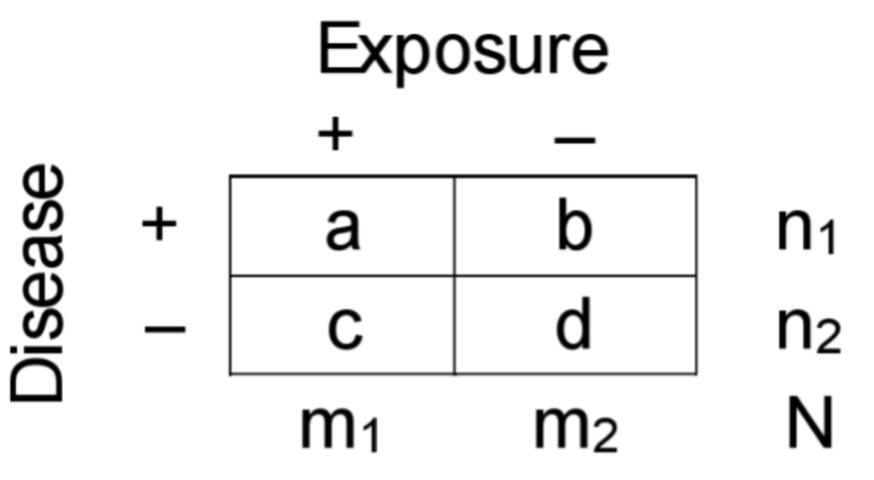
Longitudinal estimation: Incidence/Prevalence
ICexp=a/m1
ICnexp=b/m2
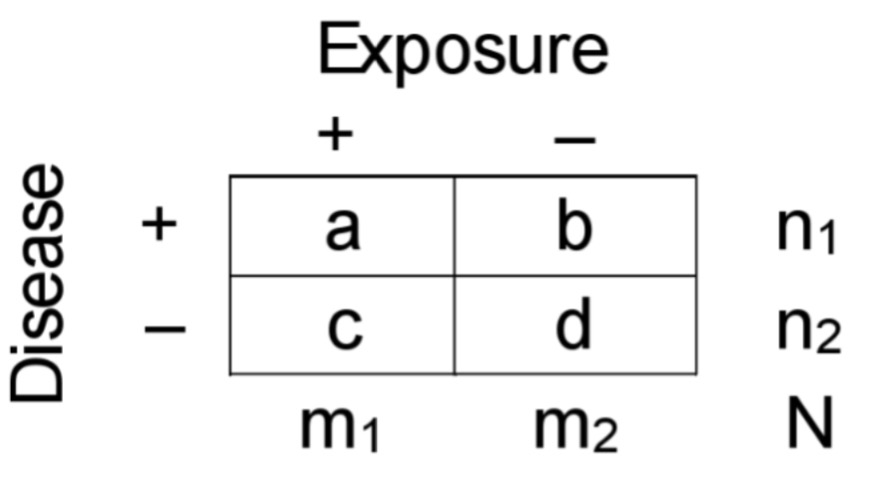
Longitudinal estimation: Odds
ODDSexp= a/c
ODDSnexp= b/d
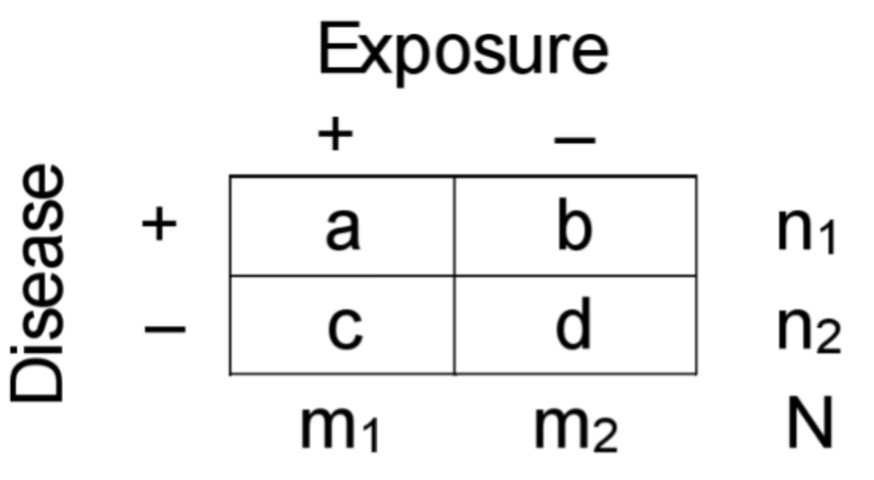
Case-control estimations: Exposure prevalence
PRexp=a/n1
PRnexp=c/n2
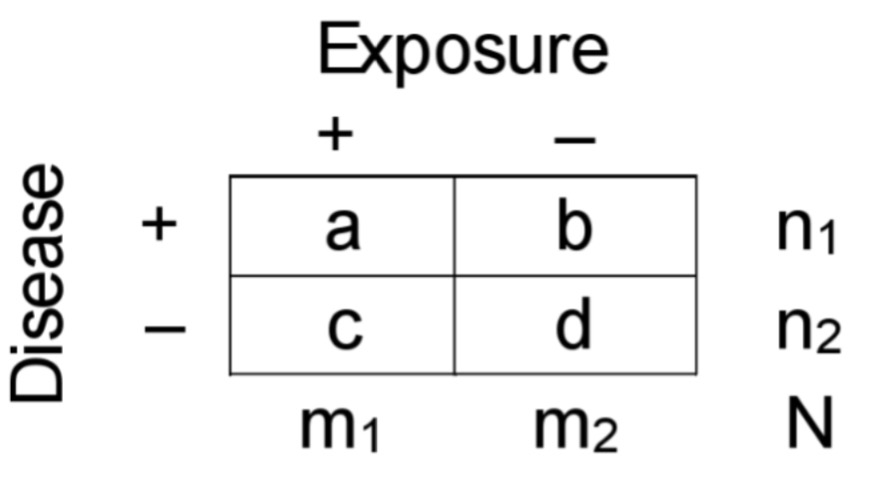
Case-control estimations: Odds
ODDSexp=a/b
ODDSnexp=c/d
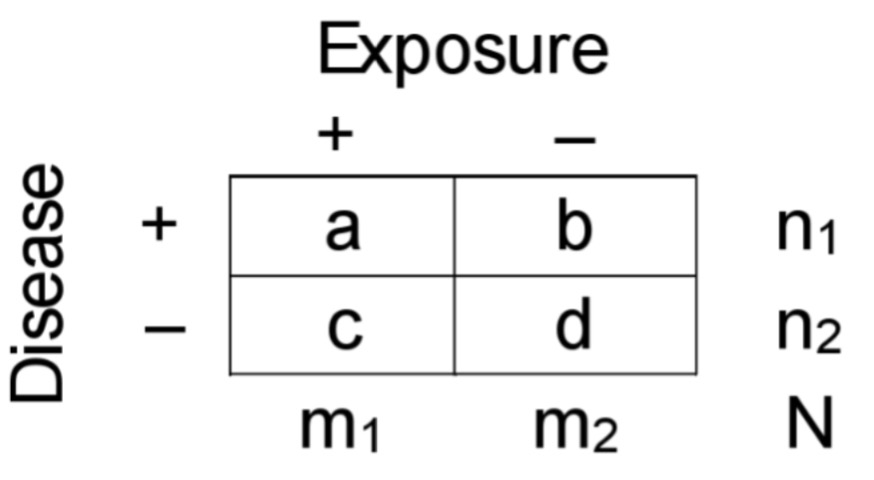
Chi-squared test
Compares the observed values in each of the categories of the table with the expected values

Degrees of freedom
An estimation of the number of independent categories in a particular statistical test
Fisher Exact Test
Used when the chi-squared approximation is not good
Used when expected values are too small
Total N<20, independent of the expected values
Total N btw 20 and 40, with expected values <5
Computationally “heavy”
Uses the exact probabilities of the hypergeometric distribution
Difference btw correlation and regression
With correlation we can only see how much two variables are related to each other
Correlation of 0.80 means that two variables are positively and strongly correlated
With the regression model, we can estimate how much one variable is affecting the other
A regression coefficient of 2.0 means that, on average, each unit increases in the exposure increases 2.0 units in the outcome
Residual
the error btw the observed values and the estimate values based on the regression